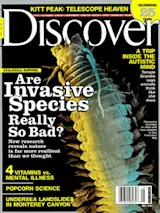Flocks of birds, herds of wildebeests and schools of fish have long intrigued scientists. How do they know to turn simultaneously? Why do they come together or break apart? How do they communicate with one another? Recently a team led by Princeton University biologist Simon Levin found a big clue to this scientific puzzle.
Using a computer model, Levin’s team found that no communication is necessary. All that is required is for any one of a few individuals to have a strong preference for a certain direction. When one of these individuals turns, everyone turns. If no one else turns, the individual gets back in the pack as a follower. “It doesn’t take much to direct the whole,” Levin says.
The computer model, designed by research fellow Iain Couzin, could lead to improved guidance systems for clusters of robots, such as those used to gather oceanographic and atmospheric data. Levin ...














